- Home
- Colleen McCullough
Life Without The Boring Bits
Life Without The Boring Bits Read online
Dedication
Dearest Anthony,
This is for you because we go back such an enormously long way, to days when you stuck your publishing neck out for me and began a friendship as deep as platonic, as enduring as chequered.
Thank you too for giving me the only title this present work can possibly sustain, for if it isn’t life without the boring bits, what is it?
With much love, always loyal, Col.
CONTENTS
Cover
Dedication
1. FREAKING AT THE CONTROLS
2. THE CRUCIFIXION
3. MIDSOMER NO MISNOMER
4. UNELECTED POWER
5. POP GOES THE PUSSYCAT
6. PORTRAIT OF A COLONIAL OVERLORD
7. ANTHROPOMORPHISM
8. HANDSOME IS AS HANDSOME DOES
9. TIME
10. THE SEPIA BLUES
11. BELITTLING BILL
12. COL ON THE WRITING OF HER BOOKS
List of published works
13. ETERNAL STATES
14. POPULATE AND PERISH
15. ONE, POTATO, TWO, POTATO
16. ON WOOD AND WARS
17. JIM
18. LAURIE
Other Books by Colleen McCullough
Copyright
FREAKING AT THE CONTROLS
Freud divided people into two kinds: those with “oral” fixations and those with “anal” fixations. Pray understand that I merely parrot the undoubtedly inaccurate generalizations that represent the good doctor’s output in the public’s mind. And onward and upward! Oral people are untidy and methodically slapdash, see the grand picture and overall purpose of a plan or a scheme, but dismiss minor details as irrelevant. Anal people are tidy and meticulously organized, see every last and most trivial detail of a plan or a scheme, but fail to grasp its overall purpose or design. Naturally there are fusions of both types, as well as one type adulterated by the veriest drop of the other, and all the various shades of grey.
I am a fusion of both types, though the anal can appear to dominate; this happens in persons who exist on a higher plane than mixtures of the two types. I speak, of course, of that most irritating of all types: the control freak. This is another term open to misinterpretation; people tend to think of control freaks as persons who want to rule the world, or their work place, or their home — putting the verb “to rule” first in importance. Such is not the case. “Control” need not mean “rule.” Control implies a judgement. Can he drive this car competently? Yes, he can, so I can sit back and relax. Can he sedate this cat without being scratched to bits? No, he can’t, so I’d better do it for him. Control is about controlling a given situation, not ruling anything — unless it’s being done badly, or, worse, incompetently.
Apropos Freud, has it ever occurred to anyone that the good doctor built a whole theory on toilet training infants/toddlers back in the days when diapers were revolting things had to be cleaned, then washed, dried, and used over and over again? A mommy couldn’t wait to sit the kid on a potty productively. Now, who cares if the kid wears a disposable diaper until it’s four? If, that is, the wallet can afford it. Kids toilet train themselves. And though world prosperity has pinnacled and is now on the decline, I predict that many domestic sacrifices will be made before the disposable diaper is abandoned. Interesting.
Okay, I have established that I am a fusion of oral and anal, and a control freak to boot. I am also an incorrigible nit-picker.
In my Yale days, I watched a neurology resident writing a report on a plain yellow pad.
“Since you can’t keep a natural margin,” I said when I had either to speak or to explode, “why don’t you draw one before you start? And your tabulations are so untidy! Do you want to enclose your numbers in parentheses or circles?”
He put his pen down and looked up at me with mild interest. “I bet you get migraines,” he said.
That’s the perfect way to squash a nit-picker flat.
The trouble is, nit-pickers can’t help themselves. There is an element of pure agony involved when, for instance, I look at sloppily presented work. I itch to write it out again for its author in glorious neatness, balm for my nit-picking soul.
Watching movies can drive me quite mad. It’s said of directors that if they get the cars in a film right, they don’t need to worry about getting anything else right. I believe it’s because film directors tend to be men, and in adolescence the only thing that matters more than girls are cars. Men love cars, that’s why the director gets them right. His accuracy also pleases the male segment of his audience. Ric will be snoozing gently through a film, then suddenly jerk and sit up straight. “There’s a 1953 De Soto! I had one of those when I was a kid.” The car drives off-screen, and he goes back to sleep. At the end of the session he’ll vote it a good film. In the meantime I’ve noticed that the guy with the gammy leg can never remember which leg is supposed to be gammy; the redhead is suddenly a blonde, and then goes back to red again without any reason; the plants in the ducal conservatory are wrong; and Hitler’s army in Russia is bogged down in mud and pouring rain, yet the sky is blue.
Roman films are money for jam to a nit-picker with knowledge of the period. They couldn’t even get the name of the hero right in Gladiator! He had a cognomen for a praenomen, a praenomen for a nomen, and a nomen for a cognomen — three out of three wrong. Even the BBC made mistakes in I, Claudius, though it was a good effort. They had the famous bronze statue of the Tuscan wolf in the Senate House, and that was correct, but the lupine old girl was suckling Renaissance twins, added later. Cicero remarks in passing to Atticus that lightning struck the suckling Romulus — the Tuscan wolf hadn’t nursed two babes, just the one who founded Rome. My favorite fluff out of this wonderful series illustrates a tragedy, despite its humor. A hefty Brian Blessed (Augustus) pins a willowy John Castle (Postumus) against a wall that bows and buckles dangerously — it’s made of cardboard! I guess they didn’t have the money for another take, so it stayed in. There’s the real rub! Those who would genuinely try for historical accuracy are on a shoe-string budget, whereas those with money to burn don’t give a tuppenny bumper anent historical accuracy. Sod’s Law in action.
Here’s one I must have seen half a hundred times over the decades: the cup of tea poured from the coffee pot. Directors clearly played hookey from a very early age, as they don’t seem to remember the rhyme about the teapot — short and stout. Coffee pots are tall and slender, designed to pour anything from pea water to unwatered pee. There is no grille of holes at the base of the spout to block the onward progress of some of the tea leaves. But, as I have always said, God gave us teeth to strain the tea leaves. I’m sure the residents of Boston knew that.
I remember reading Baroness Orczy’s series of novels about the Scarlet Pimpernel when I was ten years old. Quite why, I do not know, but the nuclear story became one of the most re-made of all beloved tales. I think my count on DVD is six versions of The Scarlet Pimpernel, starting with Leslie Howard and Merle Oberon, and going through mostly TV recreations. Perhaps it appeals to the British, who can’t say they hate the French any more, but love anything that sees a Brit shove one up a Frog. And the Scarlet Pimpernel, safely back in the early l790s, is ideal one-up-the-Frogs material. Impeccably historic, ahem.
Yet in every version they make the same mistakes, chiefly to do with knitting. Knitting, you say? But to knit is to knit! Not so. The Brits and the Frogs knit differently. What is more, the Frog way of knitting is faster and easier than the Brit. In the Frog method, one needle and the yarn do most of the work, which grows at the rate of one metre per guillotined head. The Brit method uses both needles on the yarn equally, so limps along at the rate o
f an inch per guillotined head.
Perhaps because Leslie Howard came from Czechoslovakia, he knitted the correct way, the Frog way, but no British actor since has got it right. Why is this so important? Because the Scarlet Pimpernel disguises himself as a crone at least as noisome as Madame Defarge and sits in the front row of crones watching the aristo heads fall into the basket. Knitting, knitting, knitting.
I want to see a version in which the crones whizz along Frog-style knitting, and thoroughly bored with counting aristo heads.
One crone says to the Scarlet Pimpernel, “Ma foi! Zis twenty denier yarn, she is incroyable for les turning of ze ’eels aftaire les jambons zey are feeneeshed, non?”
The S.P. leers at her evilly, sucks on his pipe. “Sure is, you reeking old crone! Excuse me, I’ll lose count — knit one, purl one, knit one, slip one, pass the slipped stitch over.”
The crone jumps, shocked clear out of her sabots. “Sacre bleu! Zat kneeting, she is not le kneeting of la Belle France! Ze yarn she is ’undred denier et les niddles zey go flic-flic, flic-flic, à l’Anglais! En avant, citoyens, en avant! ’Ere ees le Pimpernel Rouge! Keel ’eem! Keel, keel!”
A dozen men wearing the tricolored cockade in their hats dive on top of Richard E. Grant/Anthony Andrews and, boom-boom, ’ees ’ead, she ees dans le basket — a basket case, we say.
My favorite continuity disaster concerns a disaster. In Series 5 of Spooks some terrorists hold London to ransom by threatening to destroy the Thames Barrier.
I have a very soft spot for Prince Charles, for two reasons that spring immediately to mind. One is that he adores the Goon Show, which won’t mean anything to anybody, but he and I both adore it. The second reason is that he detests what modern architecture has done to London, and he’s spot-on right. When one goes to Brasilia or Pamplona, or any other of dozens of places, modern architecture is thrilling. But in London it’s a complete fuck-up of a grand old city that should have remained respectably old, in its architecture at least. I admire Prince Charles for speaking out when royalty isn’t supposed to. Well, bugger that. Someone needs to say it! Though the damage is done: the Ferris wheel is an eyesore, the Millennium Dome worse — but who gave the go-ahead to that awful little skyscraper made of colored glass shaped like an anal suppository? If I knew who was responsible, I’d have a go at shoving it right up where it belongs.
Off the soap box, Col! The Thames Barrier has a definite purpose, so it’s hard to criticise, but yellow like businesses trying to catch the eye? It should have been river-colored to blend in, not silvery-white and acid-drop yellow.
Anyway, to make a soap box go somewhere, these terrorists are threatening the Thames Barrier, which was built, as I understand it, to minimize the impact of floodwaters rushing down the Thames while simultaneously a king tide is rushing up the Thames. This particular disaster has happened before, and it can happen again; if left to its liquid fate, London would be submerged under feet of water.
We learn that the king tide peaks at 5 p.m. and the barrier has to be activated on the dot of 5 p.m. But don’t king tides do what other tides do, and rise gradually? Or is 5 p.m. the leading edge of the sine, so to speak? Spooks is not very specific. And why aren’t the super spies doing their thing clad in gumboots, macintoshes and sou’westers while the rain pours down? Against newsflashes of Oxfordshire under ghastly floods? I know that in Hertford and Hereford hurricanes hardly ever happen, but the plot surely calls for one. We may safely ignore the Hampshire weather.
Instead, the camera shows the sun shining and the Thames as placid as the wee in granny’s potty. Can this be why a tsunami is suddenly added to the plot? But can the North Sea at the Thames Estuary really generate anything like a tsunami? Tsunamis are oceanic phenomena that occur when a seismically triggered wave suddenly strikes a very wide continental shelf, which is why most earthquakes don’t cause damaging tsunamis.
The episode finishes at the beginning of Series 6, but I’m not holding my breath or rushing out to buy Series 6. It’s a perfect illustration of a scriptwriter dumped on by the trillion-ton floodwaters of his too-fertile imagination.
I am never sure whether this kind of television torment is cynically inflicted on its audience, or in true ignorance of how bad it actually is. Are scriptwriters overpaid, or underpaid? I know Jerry Bruckheimer has an Outer Mongolia for his stable of scriptwriters — CSI Miami it’s called. But whereabouts would Kudos/BBC send an erring Spooks scriptwriter? Composing the teleprompter weather for BBC Scotland? All I know about the matter is one thing: there is always an Outer Mongolia.
Control freaks don’t really want much out of life. A perfectly organized, perfectly run world will do for starters. Having organized and run a couple of weeny worlds in my day, I can testify to the fact that once people get used to method and order, they absolutely love it. “Everything has a home!” I would snarl, advancing menacingly upon a shivering professor, and waving a jar holding two chimpanzee testicles under his nose. “You know where things live — put them there, or it’s soprano time!” At first they hated this merciless treatment, but after they’d learned to put things in their homes — oh, it was so wonderful to be able to lay their hands on them immediately. If order and method weren’t among life’s necessities, control freaks wouldn’t exist. But, as some NASA and other red faces can bear witness, it helps to have nit-pickers and control freaks around. Then billions don’t get wasted for the want of a screw, or the difference between metric and imperial. Imperial is better for mensuration — stick to it!
I will tell you a true story that happened to me in another incarnation — no, no, I don’t believe in reincarnation! I use it in the sense of doing a different job wearing a different hat.
I was marking time in England for six months, and working as a temp/sec in a little city that shall be nameless. It was a precision engineering works, and the engineers loved to grab me to type their specifications because I didn’t make mistakes and would even query their calculations from time to time, thus saving the engineer a red face later on. But the pace of work in that office, which had a large pool of typists, was desperately slow; I always seemed to have time on my hands. The period, I must add, was prior to the computer age — mid 1970s will do.
One of the oldest engineers in terms of staff longevity was a man I’ll call Bob, who was responsible for the factory’s parts. For some years he had been working on a catalogue of every last part the factory contained, down to the tiniest washer. His list was long finished, but he couldn’t persuade a typist to type it for him. This wasn’t an ordinary typing job. Its object was to create a typed description on a sheet of mylar, using a sheet of yellow carbon paper in the mix as well as a carbon ribbon in the IBM machine, which had a phenomenal roller to accommodate the mylar sheet. Typewriters were massive then anyway, but the roller on this special machine was 27 inches in length. Each mylar sheet had been pre-printed into rectangular boxes that allowed for a full description of each part, each name, its code number, parts number, source — in all, I think each part had six or seven boxes across the two-foot width of a sheet. Then each sheet held the details of thirty different parts.
When Bob asked me if I would be willing to type his parts sheets in my spare time, I said yes, of course; it looked like the perfect job for a nit-picker. Bob himself was neat, precise, and ideally suited for his job. My answer was greeted with joy; I settled down with my gigantic typewriter and a parts list that ran over ten thousand items. How I loved it! The other typists could not believe that anyone could do the work and stay sane. Whereas what had driven me insane was twiddling my fingers and giggling over gossip. I pounded away with the yellow carbon reversed so it haloed the dense black print with yellow, and it was amazing how quickly I ploughed through the items. Within a month I had finished it, and done other work as well. It’s my power to concentrate; absolutely nothing impinges on the work.
Bob was so overcome that he took a cartload of mylar sheets up to the general manager’s office and showed
them off, praising me to the skies. And the manager, not a tactful man, summoned the typists together (apparently the engineers had also been singing my praises) and harangued them about their lack of a work ethic. Using as his example of the work ethic my typing of the parts catalogue. Mercifully I wasn’t asked to attend, any more than I had known of Bob’s trip upstairs, but the filthy looks and cold shoulder treatment said it all.
Here I should say that Bob was a very elderly man, probably past retirement, working for interest’s sake. He was paraplegic, couldn’t move from the waist down, and spent his waking life in a wheelchair. A really pleasant man, he never complained.
I suppose he behaved a little as if he had just had the most exciting birthday present ever, but seeing his list done at last meant a lot to him.
That was a Friday. When we came in to work on Monday, we found that someone had taken a razor-sharp blade to the huge stack of mylar sheets and slashed them to ribbons. All my work had gone for nothing, reduced to shreds littering the office floor. Which wasn’t the worst. That poor old man broke down and cried as if his heart were broken, and I suppose in a way it was. A paraplegic in a wheelchair! How deep can the poison run in some people, to do that, but especially to do it to someone who can’t stand on his own two legs and fight back?

 The October Horse: A Novel of Caesar and Cleopatra
The October Horse: A Novel of Caesar and Cleopatra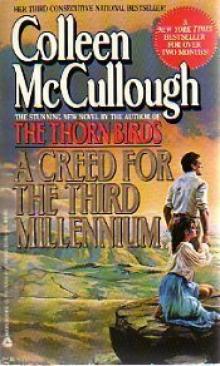 A Creed for the Third Millennium
A Creed for the Third Millennium An Indecent Obsession
An Indecent Obsession The Thorn Birds
The Thorn Birds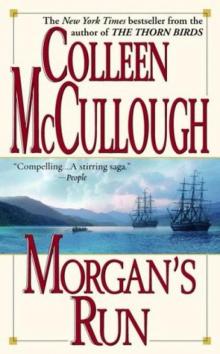 Morgan's Run
Morgan's Run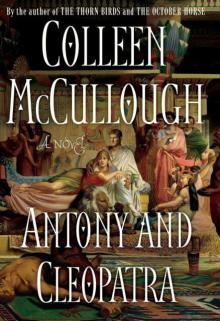 Antony and Cleopatra
Antony and Cleopatra The First Man in Rome
The First Man in Rome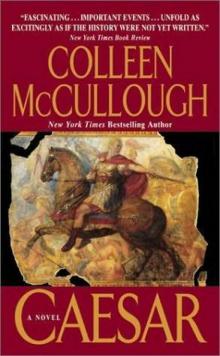 Caesar
Caesar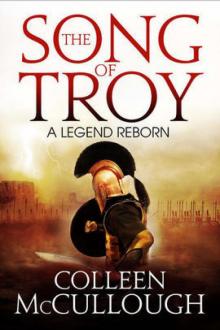 The Song of Troy
The Song of Troy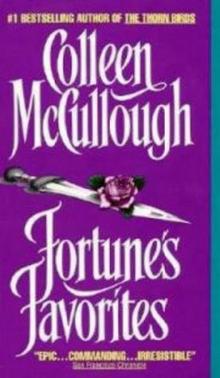 Fortune's Favorites
Fortune's Favorites The Touch
The Touch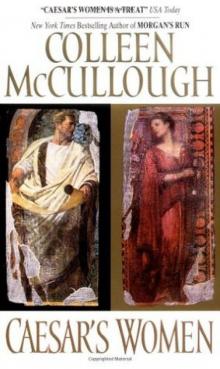 Caesar's Women
Caesar's Women The Independence of Miss Mary Bennet
The Independence of Miss Mary Bennet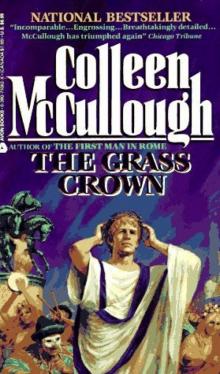 The Grass Crown
The Grass Crown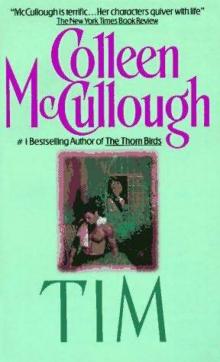 Tim
Tim Bittersweet
Bittersweet Angel
Angel 3. Fortune's Favorites
3. Fortune's Favorites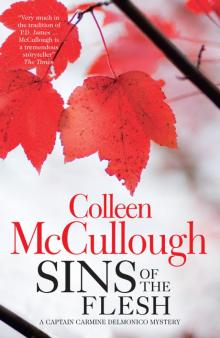 Sins of the Flesh
Sins of the Flesh 2. The Grass Crown
2. The Grass Crown Life Without The Boring Bits
Life Without The Boring Bits Masters of Rome Boxset: First Man in Rome, the Grass Crown, Fortune's Favourites, Caesar's Women, Caesar
Masters of Rome Boxset: First Man in Rome, the Grass Crown, Fortune's Favourites, Caesar's Women, Caesar Too Many Murders
Too Many Murders 1. First Man in Rome
1. First Man in Rome On, Off
On, Off 5. Caesar
5. Caesar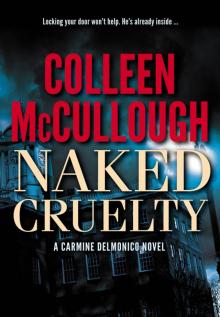 Naked Cruelty
Naked Cruelty 6. The October Horse: A Novel of Caesar and Cleopatra
6. The October Horse: A Novel of Caesar and Cleopatra